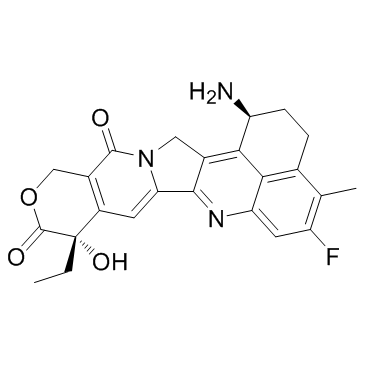| Description |
Exatecan is a water soluble topoisomerase I inhibitor, with an IC50 of 2.2 μM (0.975 μg/mL), and can be used in cancer research.
|
| Related Catalog |
|
| Target |
Topoisomerase I:2.2 μM (IC50)
|
| In Vitro |
Exatecan is a potent topoisomerase I inhibitor, with an IC50 of 0.975 μg/mL. Exatecan Mesylate (DX-8951f) significantly inhibits the proliferation of several cancer cell lines, with mean GI50s of 2.02 ng/mL, 2.92 ng/mL, 1.53 ng/mL, and 0.877 ng/mL for breast cancer cells, colon cancer cells, stomach cancer cells and lung cancer cells, respectively[1]. Exatecan Mesylate (DX-8951f) displays cytotoxic activities against PC-6, PC-6/SN2-5 cells, with mean GI50s of 0.186 and 0.395 ng/mL, respctively. Exatecan Mesylate (34 nM) stabilizes DNA-TopoI complexes in PC-6 and PC-6/SN2-5 cells[3].
|
| In Vivo |
Exatecan Mesylate (DX-8951f, 3.325-50 mg/kg, i.v.) exhibits antitumor activities in the mice model bearing tumor cells, without toxic death[1]. Exatecan Mesylate (15, 25 mg/kg, i.v.) hightly inhibits MIA-PaCa, BxPC-3 primary tumor growth in the MIA-PaCa-2 early-stage model and early-stage model of BxPC-3. Exatecan Mesylate (15, 25 mg/kg, i.v.) also significantly suppresses BxPC-3 lymphatic metastasis and completely eliminates lung metastasis in the BxPC-3 late-stage cancer model[2].
|
| Kinase Assay |
sup>[3]Cells (5×106) are lysed with SDS buffer (10 mM HEPES, 2 mM orthovanadate, 10 mM NaF, 10 mM pyrophosphate, 1 mMPMSF, 10 µg/mL leupeptin, 10% 2-mercaptoethanol, 10% glycerol,8% SDS, 42 mM Tris-HCl, 0.002% bromophenol blue, pH 7.4). Protein in the whole cell lysates is separated in 7.5% polyacryl-amide gel and blotted onto nitrocellulose membrane. The membrane is treated with anti-Topo I human antibody and subsequently, with horseradish peroxidase-conjugated protein A. The Topo I-specific band is detected with ECL reagents. To obtain a nuclear extract, cells (5×107) are washed with ice-cold buffer (2 mM K2HPO4, 5 mM MgCl2, 150 mM NaCl, 1 mM EGTA, 0.1 mM dithiothreitol), resuspended in buffer containing 0.35% Triton-X100 and PMSF and then incubated on ice for 10 min. The resulting lysates are centrifuged, and precipitates are then incubated with buffer containing 0.35 M NaCl for 1 hr at 4°C. After centrifugation (18,000g, 10 min), the protein concentration of the supernatant (nuclear extract) is determined by Bradford’s method using a protein assay kit. The same amount of nuclear protein is analyzed by Western blotting analysis using anti-Topo I antibody[3].
|
| Cell Assay |
Growth inhibition experiments are carride out in 96-well flat-bottomed microplates, and the amount of viable cell at the end of the incubation is determined by MTT assay. Thus, 500-20000 cells/well in 150 μL of medium are plated and grown for 24 h (P388, CCRF-CEM and K562 cells for 4h), the drug (including Exatecan Mesylate, in 150 μL medium/well), or the medium alone as a control, is added, and the cells are cultured for an additional 3 days. After addition of MTT (20 μL/well, 5 mg/mL in phosphate-buffered saline), the plates are incubated for 4 h and centrifuged at 800 g for 5 min, then the medium is removed and the blue dye formed is dissolved in 150 μL of DMSO. the absorbance is measured at 540 nm using a Microplate Reader model 3550[1].
|
| Animal Admin |
At 3 weeks after BxPC-3-GFP and MIA-PaCa-2-GFP orthotopic implantation, mice are randomized into five different groups of 5 mice each for treatment purposes. Group 1 serves as the negative control and does not receive any treatment. Groups 2 and 3 are treated with Exatecan Mesylate at 25 and 15 mg/kg/dose, respectively. Groups 4 and 5 receive gemcitabine treatments at 300 and 150 mg/kg/dose, respectively. At 6 weeks after BxPC-3-GFP orthotopic implantation, mice are randomized into three different groups of 20 mice each for treatment purposes. Group 1 serves as the negative control and does not receive any treatment. Group 2 is treated with 25 mg/kg/dose Exatecan Mesylate and group 3 receives 300 mg/kg/dose gemcitabine. Dosing for both drugs is performed once a week for 3 weeks, discontinued for 2 weeks, and then continued for another 3 weeks. In both early and late cancer models, primary tumor size and body weights are measured once a week. Tumor volumes are calculated using the formula a × b2 × 0.5, where a and b represent the larger and smaller diameters, respectively. At the termination of the studies, mice are sacrificed and explored. Final tumor weights and direct GFP images of primary tumor and metastases are recorded for each mouse. The tumor growth IR is calculated using the formula IR (%) = (1 − TWt/TWc) × 100, where TWt and TWc are the mean tumor weight of treated and control groups, respectively[2].
|
| References |
[1]. Mitsui I, et al. A new water-soluble camptothecin derivative, DX-8951f, exhibits potent antitumor activity against human tumors in vitro and in vivo. Jpn J Cancer Res. 1995 Aug;86(8):776-82. [2]. Sun FX, et al. Efficacy of camptothecin analog DX-8951f (Exatecan Mesylate) on human pancreatic cancer in an orthotopic metastatic model. Cancer Res. 2003 Jan 1;63(1):80-5. [3]. Joto N, et al. DX-8951f, a water-soluble camptothecin analog, exhibits potent antitumor activity against a human lung cancer cell line and its SN-38-resistant variant. Int J Cancer. 1997 Aug 7;72(4):680-6.
|
